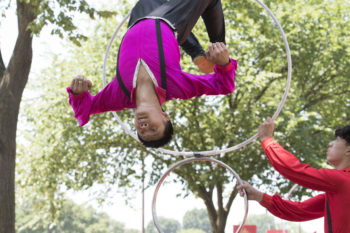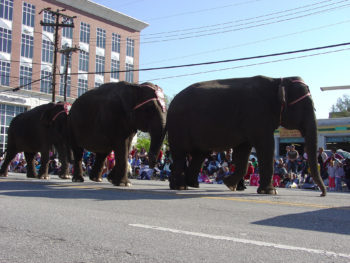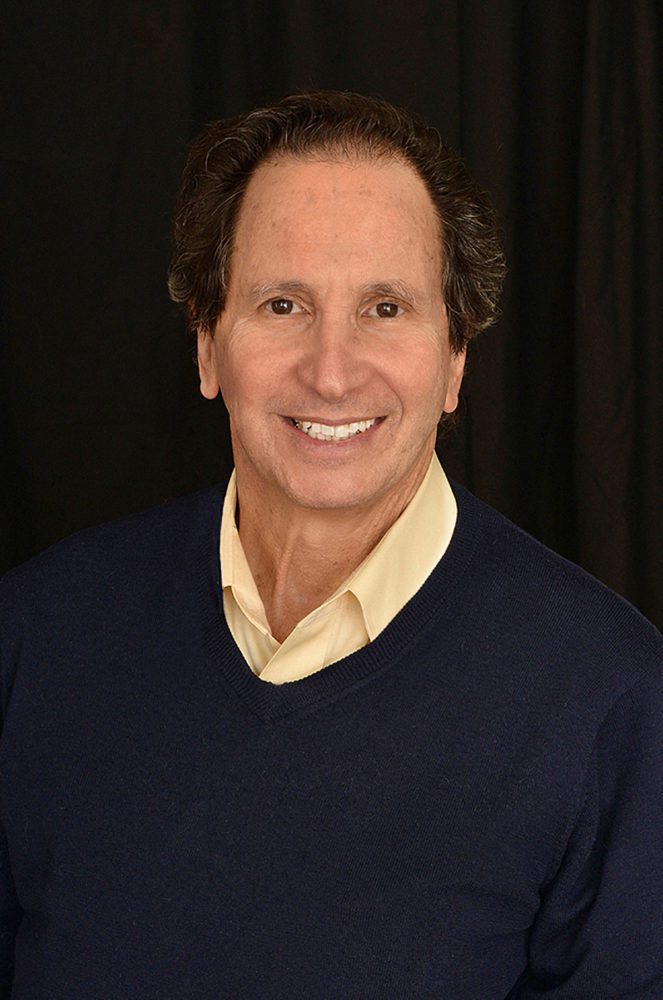The Poetry of Everyday Life Blog Post #6
This past spring I bought two tickets to the last show of the Ringling Bros. and Barnum & Bailey Circus, scheduled for May 21, 2017, in Uniondale, New York. The iconic three-ring circus, mother of all American circuses, was closing its doors after 146 years.
At the time, my friend the circus historian Richard Flint was busy researching a book commissioned by Ringling Bros. to commemorate the history of the famed circus for its 150th anniversary in 2021. Ringling didn’t make it that far.

“People call it the Greatest Show on Earth,” Richard told me, “but it was literally the Greatest Show on Earth. A large, profitable circus, Ringling was able to deliver grandeur no other show could match. Not just horses, acrobats, and clowns. Not only numerous elephants, but lavish costumes, state-of-the-art lighting, three rings, five weeks of rehearsals, Broadway choreographers to help train a bevy of showgirls and clowns, original music composed annually for each show, a live band, the best acts from around the world, and an entirely new show each season. As one friend said to me, Ringling’s demise is something like the Catholic Church shutting down.”
I attended a three-ring circus once in my childhood. My uncle Walter took my brother and me to Ringling sometime in the early 1950s, and I can still remember walking through its legendary sideshow tent past giants and fat ladies, and seeing the elephants lined up as an attraction. That one unforgettable visit sparked my imagination. You need to see the circus only once to experience its magic—and you can’t experience it on your phone. Once the images of the circus and the sideshow enter our lived experience, they emblazon our imaginations with unforgettable imagery.
The circus serves as a powerful metaphor for the poetry of everyday life. It often harbors its own elevated language: circus impresario Milton Bartok, for example, pointed his audiences’ attention to the aerialists not at the “top of the big top” but to the “lofty recesses of the big top.” The circus has kindled the imaginations of countless writers, poets, and musicians. In his poem “The Circus Animals’ Desertion” William Butler Yeats wrote: “Winter and summer till old age began / My circus animals were all on show / Those stilted boys, that burnished chariot / Lion and woman and the Lord knows what.”
In his song “Wild Billy’s Circus Story” Bruce Springsteen sings of a circus where “the flying Zambinis watch Margarita do her neck twist” and where the “circus boy dances like a monkey on barbed wire… / And the Ferris wheel turns and turns like it ain’t ever gonna stop / And the circus boss leans over, whispers in the little boy’s ear, ‘Hey son, you wanna try the big top?’”
Years ago, I used a circus metaphor to write about a crazy and wonderful girlfriend: “Rosemary, lioness of rare beauty / struts across her cage / scratching with her claws / rattling her cage! / Yet she pats with velvet paws / the keeper of the neurotic woman / who puts his head between her jaws.” Not just poets but all of us need the circus as a world apart, a world of daring, extravagance, and wonder.
A few weeks after the final Ringling Bros. show closed, the Smithsonian Institution featured circus arts as part of its Folklife Festival on the National Mall, in Washington, DC. Among the performers were members a number of youth circuses and small circuses, along with a few veteran, multi-generational performers, including Dolly Jacobs, who just two years earlier won a National Heritage Award from the National Endowment for the Arts for her career as an aerialist with Ringling Bros. and other circuses. From June 29 to July 9, visitors to the festival could see aerial acts, jugglers, tightrope walkers, and trapeze artists, and attend panels on circus lingo and circus life. This magnificent array of circuses included the Hebei Golden Eagle Acrobatic Troupe, which features two dozen of China’s top acrobats; UniverSoul Circus, which is a unique celebration of urban pop culture; the Bindlestiff Family Cirkus, based in New York City; and a number of youth circuses, including Sailor Circus Academy, from Sarasota, Florida. In contrast to the Ringling Bros.’ demise, these were ten banner days for circuses in the nation’s capital.

I attended the festival, and a number of the participants suggested that Ringling Bros.’ closing was just the end of an era, a business decision by a circus too big and unwieldy to survive (which does not appear to have been the case). One person likened it to a large oak tree that came down but that now would allow the underbrush to grow, suggesting that the small youth circuses sprouting across the United States would now be able to blossom.
The Circus Historical Society convened in the same hotel where the Smithsonian participants were housed; it promised the Greatest Convention on Earth for 2017! The meeting showcased a film about renowned tiger trainer Mabel Stark (December 10, 1889–April 20, 1968). The film depicted times when she had been mauled, her heroism, and her love for the tigers. Circus historian Charles Taylor met Mabel Stark when he was eighteen years old. He was, he said, “naive and precocious enough to ask her why she had so many wrinkles. She sweetly answered, ‘Why, dear, they are all places where I have been bit by lions or tigers. There is not a square inch on my body that doesn’t have a scar!’” Legendary juggler and Big Apple Circus performer Hovey Burgess told me that the youth circuses on the National Mall were, to use his crazy pun, a “stark” contrast to the film about Mabel Stark.
No animals—no lions, no tigers, no horses, no animals at all—were featured in the circus program. A sign at the festival read, “major compliance regulations and costs relating to sanitation, safety, and welfare (both human and animal) eliminated the presentation of exotic animals. Nonetheless, several sessions in the Circus Stories tent will discuss the role of animals in the circus.”

One of the circus participants said that if indeed animals had been allowed, protesters from People for the Ethical Treatment of Animals (PETA) would have lined the walkways to add controversy to the event, generate publicity, and put a damper on the occasion. The circus, they suggested, is a perfect target for PETA’s cause, because it guarantees publicity.
PETA and other animal-rights groups did picket Ringling Bros.’ performances for a number of years, holding up graphic signs purporting to depict the disputed mistreatment of elephants in the faces of children and families waiting to enter the big top. The Humane Society of the United States and other groups sued Ringling Bros. for its alleged mistreatment of elephants, but in 2014 their suit was thrown out by the judge when it turned out that they had paid a low-level elephant groomer to bring the suit claiming that the mistreatment hurt his personal relationship with the elephants. Despite losing the battle, the protesters and the PR nightmare they created ultimately forced Ringling Bros. to retire the circus elephants to a preserve in Florida. Without the legendary elephants, the circus seemed doomed to fail, and its demise came a year later. The Humane Society lost its legal battle against Ringling Bros. but won the war; children of all ages lost.
The Ringling Bros. elephants had been part of New York City folklore for generations. When the show was over in Madison Square Garden, the elephants paraded from the circus train through the Lincoln Tunnel with pomp and circumstance, often paying the tolls with great fanfare. New Yorkers lined the streets in the middle of the night to watch the procession. These elephants hearkened back to the beginning of Western civilization, from ancient India to the early nineteenth-century circuses. Until recently, at the Blessing of the Animals at Saint John the Divine in New York, Episcopal priests sometimes paraded an elephant in, at least once led by Gunther Gebel-Williams, Ringling’s star animal trainer in the 1970s and 80s.

The animals, clowns, and aerialists that make up the circus free the human imagination to consider the glorious possibilities of how the body moves, how animals can be trained, how human beings can choose to live dangerously, and how human beings interact with the natural world. As a child, ringmaster Johnathan Lee Iverson recalls that he thought the festooned horses he saw at the circus were actually unicorns. He told the Times reporters Sarah Maslin Nir and Nate Schweber that the world is losing “a place of wonder.” The athletic youth circuses cropping up across the country are healthy and wonderful—they are a form of gymnastics in which young acrobats await the audience’s applause rather than the judges’ scores; they are a place for retired circus performers to teach; they support many thousands of underserved young people; they are a boon to physical fitness and youth camaraderie. But no one runs away to join a youth circus.
Cruelty to animals is a serious offense. No one questions that. As Richard Flint put it, “In this day and age, those who insistently shout the loudest prevail.” I don’t believe there is any point in debating the impossible question of whether elephants are happier in their natural habitats in Africa and Asia (where they are frequently killed for their ivory tusks) or in the zoo or the circus. I’ll leave it to others to ask the elephants that question. But who is there to raise a whisper in honor of the collective creative genius that created the modern-day circus and the role it plays in sparking our imaginations. The circus in all its glory is one of humanity’s great imaginative constructs—like the opera or the sonnet. And the circus, I believe, needs to be experienced in its fullness, with animals and acrobats and clowns; those diverse attractions have defined the circus since Philip Astley, an English cavalry officer, brought the three together to create the first circus in his London amphitheater in 1770; without that combination of elements, it’s an opera without the music.

My wife Amanda and I never did get to see the last show of the Ringling Bros. and Barnum & Bailey Circus. We had a family emergency—so two seats were still available. Here’s hoping that two curious children, their eyes filled with wonder, snuck under the big top and found those seats for the last performance of the Greatest Show on Earth—and that children everywhere will always have the chance to see clowns, acrobats, tightrope walkers, tigers and elephants gallivanting under “the lofty recesses of the big top.”







3 thoughts on “The Bell Tolls for Ringling”
My grandfather took me to the Greatest Show on Earth at MSG when I was four years old. It blew my mind. Apart from that, I have no vivid memories of my four year old life. It was a beautiful experience. I am sad that I cannot take my son to it when he turns four years old.
I have new found love for Circus Arts.
I had never been until recently and after experiencing the recent Circus Arts at the Smithsonian Folklife Festival. Circus Arts help tell a story about tradition, migration, community, belonging and so much more. Wonderful piece to read. thanks.
The circumstances where performing animals are better off in day jobs– fed, well-cared-for, not stressed–are rare. And, like zoos, seeing them “in person” may spark a curiosity and passion for their natural welfare–MAY. Not sure the elephants enjoyed parading through the Lincoln Tunnel any more than we would. Ultimately, we must stop wildlife crime, banish and punish the offenders, and work for balanced ecosystems that include elephants, tigers, bears, and more. Meanwhile, circus arts and artistry is being redefined, and can flourish.